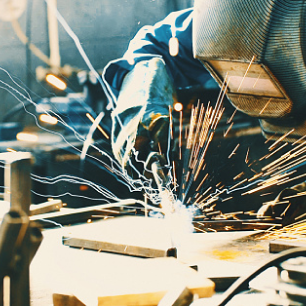Jump to:
Weld Repair of High Energy Steam Piping
In recent years, the power industry has experienced several significant failures in High Energy Steam Piping (HEP) systems from cracking in girth welds and the “crotch area” of tee sections made of P91 creep strength-enhanced ferritic (CSEF) chrome-moly alloy. The concern has prompted organizations, such as the Electrical Power Research Industry (EPRI), to issue industry safety bulletins to promote close monitoring of these components. Industry experts estimate there are thousands of tees like these currently in operation worldwide. Increased awareness and implementation of advanced inspection and nondestructive examination (NDE) programs have significantly improved safety and reduced the risk of failure and costly unplanned or forced plant outages.
As a result, energy owners, their operators, and service providers have gained tremendous knowledge in understanding the cause of failures, the most effective assessment techniques, and corrective actions in complex P91 and P92 materials. Even though the tees are designed and fabricated as per American Society of Mechanical Engineers (ASME) B16.9, Factory-Made Wrought Buttwelding Fittings, failures have become all too common. The failures are generally the result of extensive creep damage from exposure to high-stress loads in this component.
Case Studies
A metallurgical analysis was completed in one failure, and the results confirmed a possible design flaw. Chemical composition was of concern but not the main culprit. Minimum wall thickness measurements were taken around the tee and compared to values in B16.9, which is 44 mm. In Fig. 1, the through-wall thickness at the weld toes was 40 mm and below the minimum values. The tee in Fig. 2 had a through-wall crack in the crotch position on one side and a partial crack on the opposite side of the tee, originating from the inside diameter (ID). There were cracks at the toe of both run and branch girth welds originating from the outside diameter (OD).
Initially, the original equipment manufacturers (OEMs) were responsible for the design and manufacturing for efficiency and reliability, as each had its own proprietary design and manufacturing processes. Unfortunately, these never made it into the ASME Boiler and Pressure Vessel Code rules. These issues with tees are a prime example of OEMs and suppliers’ knowledge and expertise that worked well with the code even though it was not mandated. One industry expert states, “Fabrication of formed tees is a complex blacksmithing operation, and variations in geometry and thickness are expected and must be accounted for in the manufacturing operation.” One OEM followed the proper steps in fabricating formed tees and other components in the HEP system. Extensive destructive testing was conducted on full-sized tees to verify and confirm stress calculations for different designs and sizes. Then, an extensive set of rules for fabrication was created and followed during the manufacturing process, including quality control checks along the way.
Completing an in-service NDE inspection can be quite challenging due to the complex geometry, surface conditions, and environment. Having representative mockups or field-removed samples significantly increases any component’s probability of detection. It is vitally important to have as much information about the component being inspected as you can, including material specs, welding processes, heat treatment information, and hardness readings. Figure 3 shows an example of an inspection performed by Applied Inspection Systems where a significant crack was detected in the tee crotch.
Repair Alternatives
There are presently three suitable repair alternatives that most have adopted. Each owner must determine which might be the best route for their individual situation.
One method would be to locate the crack using various NDE methods and then excavate down to remove as much of the crack as possible without breaking into the ID. If the ID is breached, a purge would have to be completed, thus complicating the repair process and scheduling delays.
For method 2, the idea is to weld an overlay pad over the crotch areas. This will increase the through-wall thickness and reduce stress, but the crotch cracking remains. This method is only meant to buy time to order replacement tees, as the lead time for new replacements is quite long. Selecting the correct weld filler rod is vitally important. In any case, the fact that we’re dealing with CSEF steel implies the field weld repair process becomes more challenging and sophisticated to ensure the material properties are maintained for the service they will be subjected to. Engagement of knowledgeable material partners, planners, project managers, welders, and heat treaters is the key to maintaining high levels of quality, longevity, and safety. Given the complexity of the geometry, things as simple as maintaining the correct preheat and postweld heat treatment (PWHT) temperatures throughout are crucial to achieving the proper microstructure. As Gary Lewis of Lewis Reliability Resources has suggested in previous Welding Journal articles, heat treatment is an essential variable in this type of weld repair, and “choosing the appropriate heating device, control methodology, and execution plan are critical for material processing and optimize assets, logistics, and production to control project costs, and shorten schedules.” (See the article Heat Treatment: An Essential Variable in Energy Plant Reliability in the March 2019 Welding Journal.)
Finally, a third, relatively new, alternative weld method is prescribed in ASME and AWS codes and standards that has been implemented successfully. This method was created to preclude the need for PWHT, where conventional solutions were impractical due to structural constraints, resource availability, or other factors driving the decision process. In 2015, EPRI and their utility members, along with technical experts from materials labs and leadership from the construction code groups at the National Board Inspection Code and ASME, began the process of developing this technique. The method has been recognized inside the industry as a welcomed approach to weld repair and new procedures identified as Weld Method 6 and Supplement 8. Figure 4 shows the process of tee crotch repairs from the initial detection to the final weld repair.
In Closing
One valuable lesson learned to ensure a successful repair is that once welding is complete and the weld repaired tee is back to normal room temperature, a pre-PWHT volumetric inspection must be completed to ensure weld cleanliness. Once this is achieved, complete the PWHT as per procedures and process, and then conduct the final PAUT inspection. An effective condition assessment program should include wall thickness measurements, chemical analysis, and hardness testing, along with a couple of NDE methods, including magnetic particle testing and PAUT.
JEREMY RING (jeremy.ring@appliedinspection.com) is director of business development, ASNT NDT Level II (MT, PT, UT, and VT) at Applied Inspection Systems, Advanced Technology Center, Huntersville, N.C.
TERRY HAIGLER (terry.haigler@appliedinspection.com) is director of business development, ASNT NDT Level III (MT, PT, UT, and VT) at Applied Inspection Systems, Advanced Technology Center, Huntersville, N.C.


